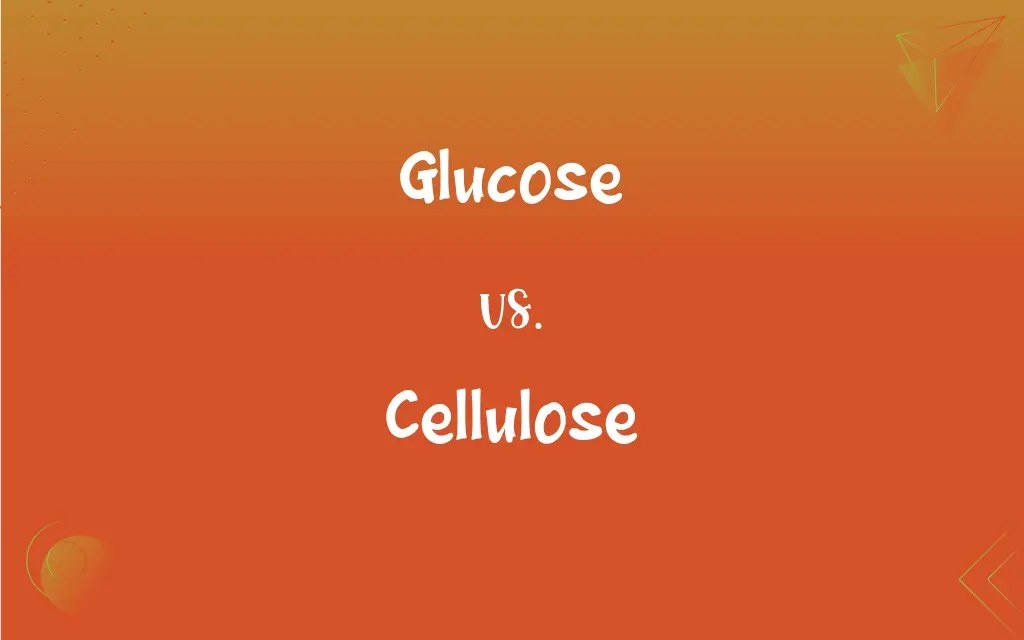Glucose vs. Cellulose: What's the Difference?
Edited by Aimie Carlson || By Janet White || Published on February 22, 2024
Glucose is a simple sugar and a key energy source for living organisms, while cellulose is a complex carbohydrate forming the structural component in plant cell walls.

Key Differences
Glucose is a monosaccharide, or simple sugar, that is a primary source of energy for cells in living organisms. It is crucial in metabolic processes. Cellulose, on the other hand, is a polysaccharide, composed of long chains of glucose molecules, and serves as a structural component in plants.
In the human body, glucose is vital for generating energy, particularly in the brain and muscles. It circulates in the blood and is regulated by insulin. Cellulose is not digestible by humans but is a dietary fiber that aids in digestion and maintaining a healthy gut.
Glucose is easily absorbed and utilized by the body, making it a quick energy source. It can be found in foods like fruits, honey, and carbohydrates. Cellulose, however, has a rigid structure that provides strength and rigidity to plant cells, crucial for plant growth and stability.
On a molecular level, glucose molecules are single units that can be quickly metabolized. In contrast, cellulose molecules are bonded together in a way that makes them resistant to being broken down easily, providing structural support rather than energy.
In industry, glucose is used in food products, beverages, and in medical treatments for energy supply. Cellulose is used for making paper, textiles, and as a food additive for texture and fiber content.
ADVERTISEMENT
Comparison Chart
Type of Carbohydrate
Simple sugar (monosaccharide)
Complex carbohydrate (polysaccharide)
Role in Living Organisms
Primary energy source
Structural component in plants
Digestibility
Easily digestible and used for energy
Not digestible by humans, used as dietary fiber
Molecular Structure
Single glucose units
Long chains of glucose molecules bonded together
Industrial Uses
Food, beverages, medical treatments
Paper, textiles, food additives
ADVERTISEMENT
Glucose and Cellulose Definitions
Glucose
The primary sugar found in the bloodstream, regulated for energy metabolism.
Diabetics must carefully monitor their blood glucose levels.
Cellulose
A complex carbohydrate forming the structural component of plant cell walls.
Cellulose gives plants the necessary rigidity and strength to stand upright.
Glucose
Used in medical treatments as a quick energy source and for nutritional therapies.
In the hospital, glucose solutions are often given intravenously to patients in need of energy.
Cellulose
Composed of long chains of glucose molecules, indigestible by humans.
Cellulose is a major source of dietary fiber in fruits and vegetables.
Glucose
A simple sugar that is an essential energy source for living organisms.
The athlete consumed a glucose drink to quickly replenish energy levels.
Cellulose
Provides dietary fiber that aids in digestion and gut health.
High cellulose content in a diet can improve digestive health.
Glucose
A monosaccharide that is crucial in cellular respiration and energy production.
Glucose is broken down during cellular respiration to release energy.
Cellulose
Not used for energy but for providing structural support in plants.
The cellulose in cotton fibers is what makes them strong and durable.
Glucose
Derived from carbohydrates in the diet and stored as glycogen in the body.
Post workout, he ate a meal high in glucose to restore his glycogen stores.
Cellulose
Used in the manufacturing of paper, textiles, and as a food additive.
The paper industry relies heavily on cellulose derived from wood pulp.
Glucose
A monosaccharide sugar, C6H12O6, that is used by living things to obtain energy through the process of aerobic respiration within cells. It is the principal circulating sugar in the blood of humans and other mammals.
Cellulose
A polysaccharide, (C6H10O5)n, that is composed of glucose monomers and is the main constituent of the cell walls of plants. It is used in the manufacture of numerous products, including paper, textiles, pharmaceuticals, and insulation.
Glucose
A colorless to yellowish syrupy mixture of dextrose, maltose, and dextrins containing about 20 percent water, used in confectionery, alcoholic fermentation, tanning, and treating tobacco. Also called starch syrup.
Cellulose
A complex carbohydrate that forms the main constituent of the cell wall in most plants and is important in the manufacture of numerous products, such as paper, textiles, pharmaceuticals, and explosives.
Glucose
(carbohydrate) A simple monosaccharide (sugar) with a molecular formula of C6H12O6; it is a principle source of energy for cellular metabolism.
Cellulose
(organic compound) A polysaccharide containing many glucose units in parallel chains.
Glucose
A variety of sugar occurring in nature very abundantly, as in ripe grapes, and in honey, and produced in great quantities from starch, etc., by the action of heat and acids. It is only about half as sweet as cane sugar. Called also dextrose, grape sugar, diabetic sugar, and starch sugar. See Dextrose.
Cellulose
Consisting of, or containing, cells.
Glucose
Any one of a large class of sugars, isometric with glucose proper, and including levulose, galactose, etc.
Cellulose
Consisting of, or containing, cells.
Glucose
The trade name of a sirup, obtained as an uncrystallizable reside in the manufacture of glucose proper, and containing, in addition to some dextrose or glucose, also maltose, dextrin, etc. It is used as a cheap adulterant of sirups, beers, etc.
Cellulose
The substance which constitutes the essential part of the solid framework of plants, of ordinary wood, cotton, linen, paper, etc. It is also found to a slight extent in certain animals, as the tunicates. It is a carbohydrate, (C6H10O5)n, isomeric with starch, and is convertible into starches and sugars by the action of heat and acids. When pure, it is a white amorphous mass. See Starch, Granulose, Lignin.
Unsized, well bleached linen paper is merely pure cellulose.
Glucose
A monosaccharide sugar that has several forms; an important source of physiological energy
Cellulose
A polysaccharide that is the chief constituent of all plant tissues and fibers
FAQs
What is glucose?
Glucose is a simple sugar essential for energy production in living organisms.
How does the body use glucose?
The body uses glucose as a primary energy source, especially for the brain and muscles.
Is cellulose digestible by humans?
No, humans cannot digest cellulose, but it serves as an important dietary fiber.
What is cellulose?
Cellulose is a complex carbohydrate that forms the structural component of plant cell walls.
Where is glucose found in the diet?
Glucose is found in carbohydrates like fruits, honey, and grains.
Can glucose be stored in the body?
Yes, glucose can be stored as glycogen in the liver and muscles.
Is glucose a monosaccharide or polysaccharide?
Glucose is a monosaccharide, a single sugar unit.
Can athletes use glucose supplements?
Athletes often use glucose supplements for quick energy during prolonged physical activity.
How is glucose monitored in diabetes?
In diabetes, blood glucose levels are monitored using glucose meters or continuous glucose monitoring systems.
How is cellulose extracted from plants?
Cellulose is extracted from plants through mechanical and chemical processes, especially in papermaking.
What are the industrial uses of cellulose?
Cellulose is used in making paper, textiles, and as a food additive for texture.
Why is cellulose important in plants?
Cellulose provides strength and rigidity to plant cells, essential for plant stability and growth.
How do plants produce cellulose?
Plants synthesize cellulose from glucose through photosynthesis.
What role does cellulose play in human nutrition?
As dietary fiber, cellulose aids in digestion and maintaining gut health.
Does cooking affect cellulose in food?
Cooking can soften cellulose, making plant-based foods easier to eat and digest.
Is glucose used in energy drinks?
Yes, glucose is often used in energy drinks for quick energy replenishment.
What makes cellulose fibers strong?
The bonding of glucose molecules in cellulose gives it strength and durability.
Can the body convert other sugars to glucose?
Yes, the body can convert other sugars and carbohydrates into glucose for energy.
Can cellulose be used in biofuels?
Yes, cellulose can be used in the production of biofuels like cellulosic ethanol.
Are there health risks associated with high glucose intake?
Excessive glucose intake can lead to health issues like obesity, diabetes, and tooth decay.
About Author
Written by
Janet WhiteJanet White has been an esteemed writer and blogger for Difference Wiki. Holding a Master's degree in Science and Medical Journalism from the prestigious Boston University, she has consistently demonstrated her expertise and passion for her field. When she's not immersed in her work, Janet relishes her time exercising, delving into a good book, and cherishing moments with friends and family.
Edited by
Aimie CarlsonAimie Carlson, holding a master's degree in English literature, is a fervent English language enthusiast. She lends her writing talents to Difference Wiki, a prominent website that specializes in comparisons, offering readers insightful analyses that both captivate and inform.
































































